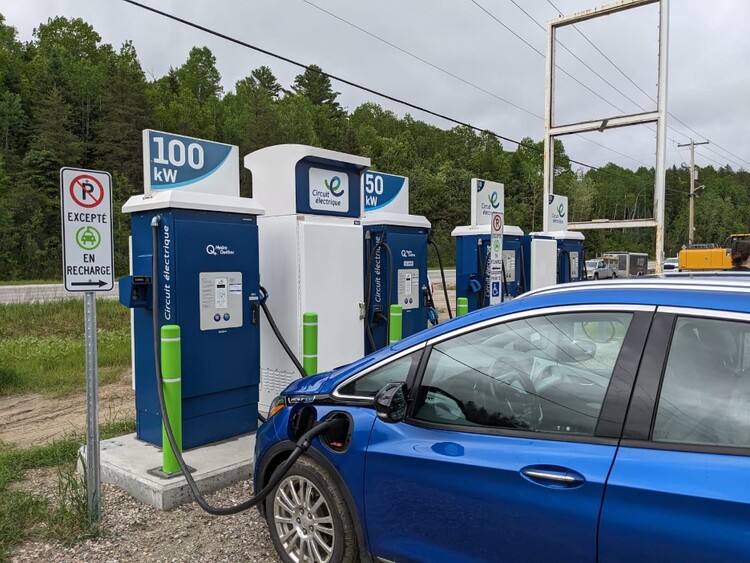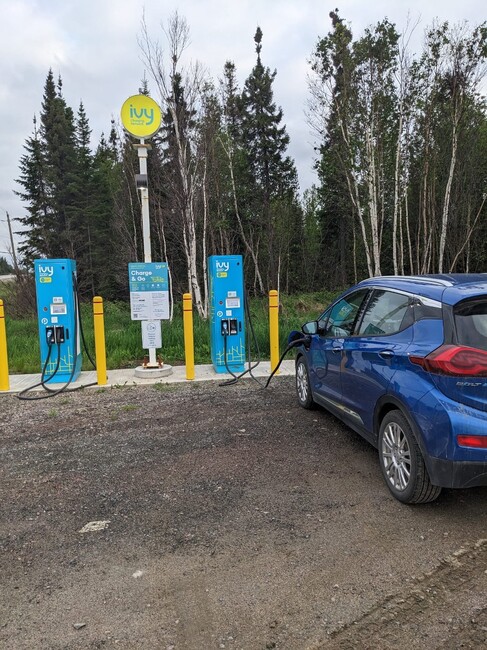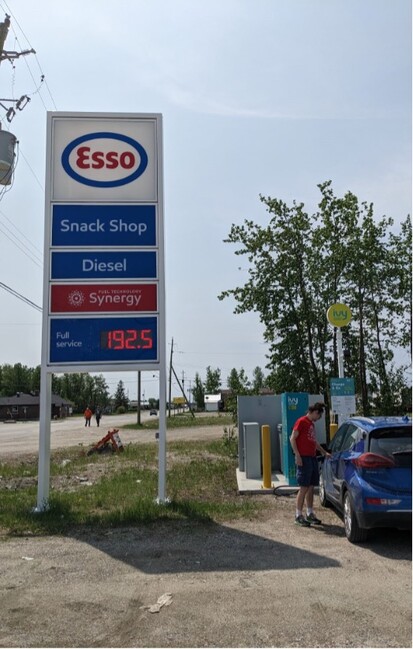Electrifying vacation: across the country in an electric vehicle
Posted on
Charging the electric car
Busy as they might be solving problems related to the energy transition, even our researchers deserve a break once in a while. One of our PhD students, Matt Labbe, spent some of his summer trekking across the country with his dad and brother—in an electric vehicle! Matt shared his experience with us:
“Are you crazy?” is probably my favourite response I’ve gotten when I tell people I did a cross-Canada road trip in an electric vehicle (EV). My brother—who lives in British Columbia—and my Dad and I—who both live in Alberta—were all headed to a family reunion in Quebec. Instead of flying, we chose to drive. My brother, with his 2020 Chevrolet Bolt, insisted we take his car: “Think of the money we’ll save on gas.” Besides, the electricity used to charge the car became a lot greener the further east we went, with our destination (Quebec) generating most of their energy through hydroelectricity. For fun, we even stopped in Niagara Falls to see the world’s first hydroelectric plant.

Stopping to charge your car during a long road trip is not nearly as bad as people might think. Sure, it adds an extra hour or two to your day, but it breaks up the long drive into more digestible servings. In any case, my rickety old father needed to stretch his legs every two hours anyway, so it worked out nicely for us. A key aspect when driving an EV is planning. Plan your route, plan your stops. We planned our longest charges to coincide with meal time, so we could go to dinner, take our time, and come back to a fully charged car.
We still needed a few “top-ups” between meals, but they were more on the order of 20-30 minutes. EV chargers in the cities are usually located at shopping centres, so there’s always something you can do. When you’re traveling cross-country though, EV chargers are at gas stations. Nevertheless, I found our stopping frequency to synchronize quite nicely with bathroom breaks, and it allowed me to stay much more hydrated than what would have been possible with a gasoline car. It also gave us a chance to talk with people at the charging stations. Other EV drivers love to discuss the lifestyle, while gasoline-loving onlookers always ask, “how long does it take to charge?” The answer, of course, is that it depends. If we’re talking from practically dead up to 80% (which is as high as you generally want to charge the batteries), our answer was about an hour. Those were the meal time charges.

Naturally, there were some downsides to travelling across Canada in an EV. The biggest, by far, is the charging network, or lack thereof. In some places, the nearest charger was 250 km away, so we had to make sure our car was charged enough to make it. Let me just say that range anxiety is real, and that if your estimated remaining range is less than your next charger, you learn how to drive economically. The rate at which energy is consumed is a function of your speed: drive faster, and you use up more energy. My dad’s counter-argument was that you can go further, when you drive faster, but trust me when I say it doesn’t work that way.
My brother and I played a game: if our remaining range was less than a 20 km buffer from our next charger, we drove slower. If we had energy to spare, we could afford the extra speed. All-in-all, it changes your mindset when driving. You’re much more aware of your real-time “fuel” efficiency and you change your driving habits accordingly. When you drive a gasoline car, you still burn more gas when you drive faster, but that number isn’t calculated and shown on your dashboard! This change in driving mentality isn’t necessarily a bad thing, in my opinion.
As the number of chargers in Canada increases though (and it will!), range anxiety will be cured, so long as the chargers work. That’s another issue. A lot of Canada’s charging network was unreliable, where two or more chargers weren’t working. In fact, one EV driver we met along the way had to detour their entire route through Ontario on the highway they wanted to use because three charging stations in a row were out of order.

Another aspect of driving an EV that my traditionally-minded father was apprehensive about was the integration with technology. It makes perfect sense that an electric vehicle would be governed by electric devices, but for those of us that haven’t tweeted in our lifetime, it may be challenging. The best example of this is finding a charger. For my brother, finding a charger is as easy as opening an app on his phone. There are some great resources out there, and he planned our travel route with the chargers available to us. To pay for charging, he also had apps on his phone that billed directly, with no need to handle credit cards at the charger. Once you climb the initial learning curve, it’s smooth sailing thereafter.
Driving across Canada in an EV was a memorable experience, and one that I won’t shy away from doing again. Stopping to charge is a nice break from driving, allowing you to take in the sights of Canada, and laugh at the price of gas. I would also like to note that the EV we used has one of the smallest batteries and some of the slowest charging rates of the many EV choices out there. My experience of road trips in an EV will only get better!
Read more about Matt Labbe and his research into zinc-air batteries here!